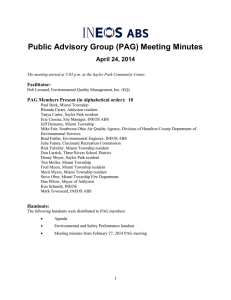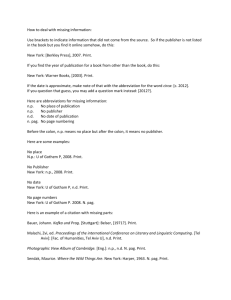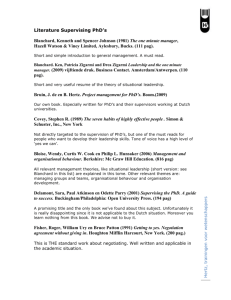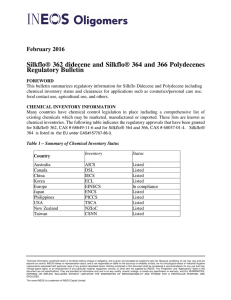Public Advisory Group (PAG) Meeting Minutes
advertisement
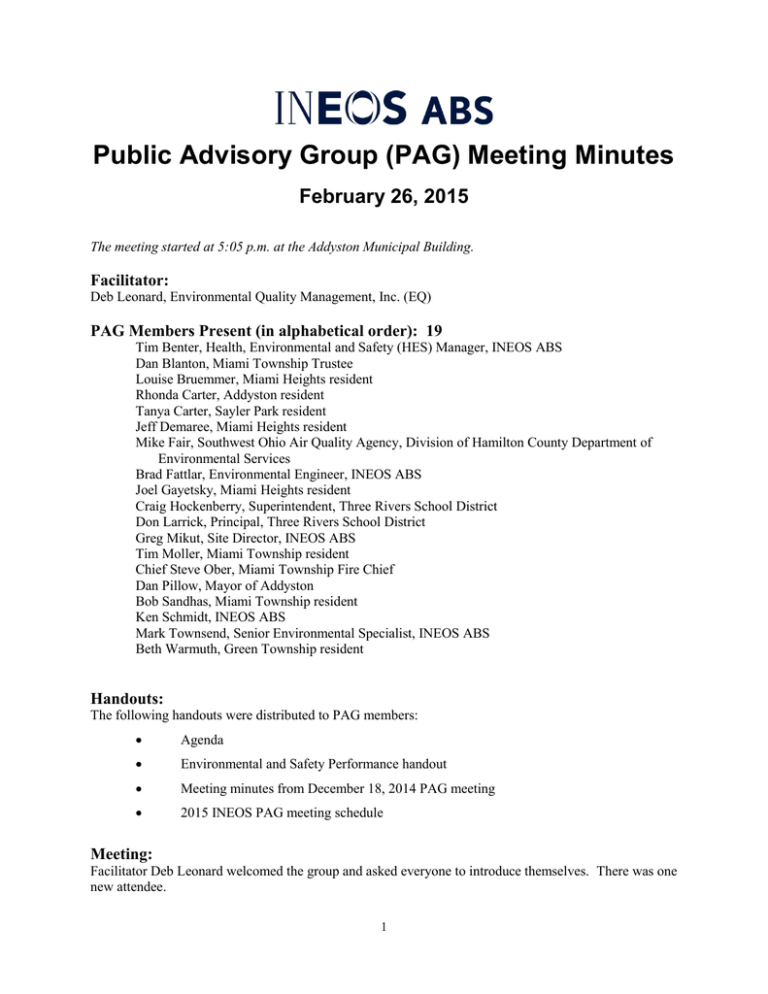
Public Advisory Group (PAG) Meeting Minutes February 26, 2015 The meeting started at 5:05 p.m. at the Addyston Municipal Building. Facilitator: Deb Leonard, Environmental Quality Management, Inc. (EQ) PAG Members Present (in alphabetical order): 19 Tim Benter, Health, Environmental and Safety (HES) Manager, INEOS ABS Dan Blanton, Miami Township Trustee Louise Bruemmer, Miami Heights resident Rhonda Carter, Addyston resident Tanya Carter, Sayler Park resident Jeff Demaree, Miami Heights resident Mike Fair, Southwest Ohio Air Quality Agency, Division of Hamilton County Department of Environmental Services Brad Fattlar, Environmental Engineer, INEOS ABS Joel Gayetsky, Miami Heights resident Craig Hockenberry, Superintendent, Three Rivers School District Don Larrick, Principal, Three Rivers School District Greg Mikut, Site Director, INEOS ABS Tim Moller, Miami Township resident Chief Steve Ober, Miami Township Fire Chief Dan Pillow, Mayor of Addyston Bob Sandhas, Miami Township resident Ken Schmidt, INEOS ABS Mark Townsend, Senior Environmental Specialist, INEOS ABS Beth Warmuth, Green Township resident Handouts: The following handouts were distributed to PAG members: Agenda Environmental and Safety Performance handout Meeting minutes from December 18, 2014 PAG meeting 2015 INEOS PAG meeting schedule Meeting: Facilitator Deb Leonard welcomed the group and asked everyone to introduce themselves. There was one new attendee. 1 1) Introduction to Greg Mikut, the new INEOS Site Director 2) Greg Mikut is the new Site Director at the Addyston plant, since January 2015. He is from Pittsburgh and has a chemical engineering degree from the University of Pittsburgh. He has more than 20 years of experience, with a focus on polymer science and engineering. His first position out of school was at an Amoco Performance Products plant in Marietta, Ohio. He is currently still the Site Director at another INEOS site in Channahon, IL (a former Styrolution facility). As soon as that site transitions to its new Site Director, he will begin working full-time in Addyston. The Addyston plant, which is currently in the INEOS ABS division, will become part of a new INEOS division in the near future to be called INEOS Styrolution. It will be comprised of all INEOS ABS sites across the world and all former INEOS Styrenics Division sites. INEOS recently purchased the remaining shares of a joint venture (called Styrolution) with BASF in November 2014 that included the former Styrenics Division sites. Greg’s role is to bring the Addyston plant into the new INEOS Styrolution division. The plant will be making the same products as before and may expand its production. Site Safety Performance Update — Tim Benter, Health, Environmental & Safety Manager, INEOS ABS OSHA Recordable Injuries - First Aid Incidents - 3) The plant has experienced one OSHA recordable injury since the last PAG meeting on December 18, 2014. On January 8, 2015, a technician strained her groin after slipping on an icy trench in the railcar washing area. The plant is looking into ways to prevent an incident like this, such as not washing railcars during extremely low temps. The plant has experienced no first aid injuries since the last PAG meeting on December 18, 2014. Environmental Performance Update — Brad Fattlar, Environmental Engineer, INEOS ABS and Mark Townsend, Senior Environmental Specialist, INEOS ABS Plant Alarms - The plant has experienced one real fire alarm since the last PAG meeting on December 18, 2015. On February 26, 2015, there was a gearbox fire in 9 Building. Personnel were draining oil from a gearbox in order to perform some maintenance, but didn’t turn the heater off. The heater ignited the residual oil. The plant’s on-site incident commander responded. It was a small fire that was put out using dry chemical. - The plant experienced four false alarms due to frozen sprinkler heads and frozen fire risers in various buildings due to extreme cold temperatures. 2 - The plant conducted an emergency response drill on December 29th simulating an unresponsive worker. - The alarm is tested once a month at 11 a.m. (first Wednesday of each month). Equipment Malfunctions - To date in 2015, there have been 9 equipment malfunctions, totaling 287 pounds of chemicals released into the atmosphere. - There have been 10 equipment malfunctions since the last PAG meeting on December 18, 2014: o December 30, 2014 – 30 Building main duct and thermal oxidizer vents were diverted to the atmosphere due to a problem with the area’s control system. About 2 pounds of chemicals were released. o January 7, 2015 – The temperature switch on the hydraulic oil heater for the thermal oxidizer failed, diverting process emissions to the atmosphere. About 2 pounds of chemicals were released. o January 8, 2015 – Due to a natural gas curtailment from Duke Energy, the plant had to switch to a backup boiler that uses No. 2 fuel oil. There were some technical difficulties during the switching due to the cold temps that resulted in the main duct diverting emissions to the atmosphere. About 31 pounds of chemicals were released. o January 10, 2015 – A high lower explosion limit (LEL) reading was detected from a sensor in the main duct, causing diversion of emissions to atmosphere. The reading was false, likely due to moisture in the duct (which affects the operation of the sensors). Note: An LEL is the lowest concentration (percentage) of a gas or a vapor in air capable of producing a flash of fire in presence of an ignition source. The emissions are diverted to atmosphere to prevent a fire. About 2.5 pounds of chemicals were released. o January 24, 2015 – An outlet valve on the thermal oxidizer failed throughout most of the day, causing diversion of emissions to atmosphere. About 1 pound of chemicals was released. o January 27, 2015 – A high lower explosion limit (LEL) reading was detected from a sensor in the main duct, causing diversion of emissions to atmosphere. The reading was false, likely due to moisture in the duct (which affects the operation of the sensors). About 3 pounds of chemicals were released. o January 27, 2015 – A compressor for the boiler failed after personnel put cold oil in it that didn’t flow properly, causing diversion of emissions to atmosphere. About 102 pounds of chemicals were released. o February 14, 2015 – High lower explosion limit (LEL) readings were detected from all three sensors in the main duct, with continued problems with one of the sensors, causing diversion of emissions to atmosphere. About 36 pounds of chemicals were released. 3 o February 19 and February 20, 2015 – Due to natural gas curtailments from Duke Energy, the plant had to switch to a backup boiler that uses No. 2 fuel oil. There were some technical difficulties switching to the backup boiler due to the extreme cold temperatures that resulted in the main duct diverting emissions to the atmosphere. The plant has added heat tracing and insulation to valves that will minimize or eliminate switching difficulties due to the cold. About 89 pounds of chemicals were released. o February 23, 2015 – An LEL sensor in the main duct was removed without being properly bypassed, causing diversion of emissions to atmosphere. About 21 pounds of chemicals were released. o Note: The malfunctions were primarily due to issues related to gas curtailments and false readings on LEL sensors. There was discussion about the gas curtailments, as Duke Energy normally gives the plant a three-hour notice to stop using gas, but the plant needs 4-6 hours to properly shut down its processes. The plant will be discussing this issue with Duke Energy. The plant is also looking into trialing new LEL sensors that are less sensitive to moisture. Community Feedback - To date in 2015, there has been 1 community complaint for a chemical odor. - Since the last PAG meeting on December 18, 2014, there has been 1 community complaint for a chemical odor: o February 4, 2015 – A complaint was called in to the plant following a small spill of TDM (tertiary-dodecyl mercaptan), a very odorous chemical. Mercaptan is used to give natural gas its odor. 1 of 1 complaint has been linked to the plant. Consent Decree Closure - The plant has not closed out its Consent Decree yet, but expects action by a judge soon. - The plant will discuss what it was required to do under the Consent Decree as compared to what it is required to after the Consent Decree is closed out at the April 2015 PAG meeting. - The public comment period for the plant’s new Permit to Install (PTI) for the plant’s emulsion process has closed. The PTI has been issued. The judge will then need to sign off on the closure of the Consent Decree. - Once the Consent Decree closes, the plant is not under obligation to continue paying for air sampling at Kibby Lane. The plant is discussing the continuation of the sampling program with Hamilton County. More details to be reported at the April 2015 PAG meeting. - Note: Several PAG members noted that the community would be concerned if the air monitoring at Kibby Lane did not continue. 4 4) 5) 6) Citizen Complaints — Mike Fair, Southwest Ohio Air Quality Agency (a division of HCDES) No complaints were called in to the Southwest Ohio Air Quality Agency since the last PAG meeting on December 18, 2014. There was a butadiene detection of 18 parts per billion (ppb) at the Kibby Lane monitor on January 18, 2015. This detection is not considered a risk to human health, but it was high compared to previous butadiene detections and it was high independent of styrene and acrylonitrile emissions for that day. Tim Benter of INEOS said the detection was the result of a “dead batch” in the rubber kettles. A dead batch is butadiene that won’t polymerize. The winds were blowing from the plant toward the monitor most of the day. To dispose of the dead batch, the plant sent the unreacted mixture to the plant’s flare roughly over a 24-hour period. A vessel was opened up for cleaning after the flaring was complete. Vacuum was held on the vessel for several hours before opening it up to minimize remaining residual Butadiene. The cleaning still potentially added residual butadiene to the atmosphere. An investigation into the cause of the dead batch is in progress. Future actions will be made to further minimize the residual Butadiene remaining in the tank. There was also a styrene detection of 5 ppb on February 11, 2014. The plant will be investigating this and will report back at the next PAG meeting. Plant Business News — Greg Mikut, Site Director, INEOS ABS Business is pretty solid. The plant met three of its five performance goals for 2014: earnings, fixed costs and health, environmental and safety. The plant did not meet its reliability goal due to cold weather in early 2014 or its working capital goal. There will be some layoffs (due to redundancy) as a result of the integration with the Styrolution plants. Integration with Styrolution is a huge positive for the Addyston plant. INEOS Styrolution is committed to operating safely and reliably. The plant does benchmarking against other INEOS plants for metrics such as OSHA recordables. Other Business Deb discussed the plant’s annual community newsletter, which will be prepared and sent out following the closure of the plant’s Consent Decree. Deb surveyed the group for potential newsletter topics. She will send an email to the entire PAG group following the meeting asking for newsletter topics. The topics suggested at the PAG meeting included: - Consent Decree – what’s different for the plant post-Consent Decree? - Plant integration with Styrolution - Article on Greg Mikut, the new Site Director 5 7) - Article on a plant employee, perhaps the female shift coach - Status of Kibby Lane monitoring Community News Addyston - In the planning stages right now. Have a planning retreat scheduled to go over their new Master Plan. - Trying to work out problems with GPS that is sending plant truck traffic through side streets in Addyston. - Working to improve relationship between police force and kids in Addyston Three Rivers School District - Hosting big events at the school due to its size, such as the Division IV basketball tournament. Also, auditorium seats 700. - Craig Hockenberry is the new superintendent. He took Rhonda Bohannon’s place. Sayler Park - Farmers market is still being held throughout the winter at an inside location. - New housing development is underway. Miami Township - 8) Battling snow and ice, digging out fire hydrants. Planning for Next Meeting The next PAG meeting will be April 23, 2015 at the Sayler Park Community Center. The meeting adjourned at 6:30 p.m. 6
